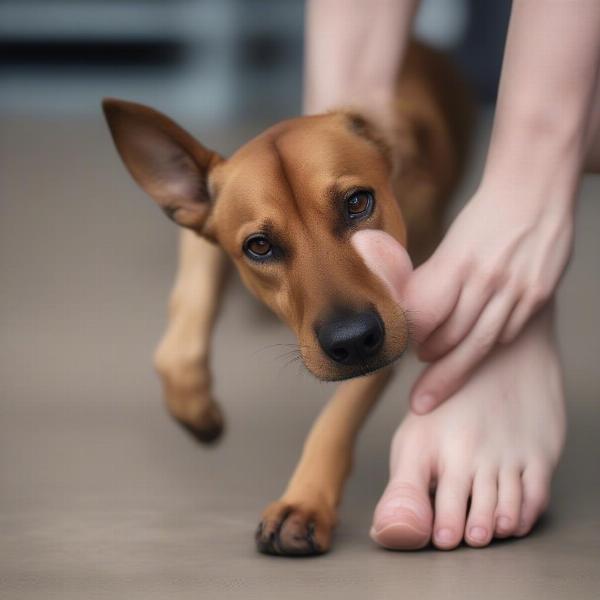A dog’s leg injury can be a stressful experience for both the pet and the owner. Recognizing the signs of a broken leg is crucial for prompt veterinary care and a smoother recovery. This article will guide you through identifying potential signs, understanding the importance of immediate action, and preparing for the next steps if you suspect your dog has a broken leg.
Recognizing the Signs of a Broken Leg in Dogs
If your dog has suffered a leg injury, they’ll likely exhibit noticeable changes in behavior and movement. Look for the following signs:
- Obvious pain: Whining, yelping, or whimpering, especially when the leg is touched or moved. They may also lick the injured area excessively.
- Limping or inability to bear weight: Your dog might hold the leg up entirely, refuse to walk, or exhibit a pronounced limp.
- Swelling or bruising: The injured area may appear swollen and discolored.
- Deformity: The leg may appear bent or at an unnatural angle.
- Grinding or clicking sound: This can indicate broken bone ends rubbing together.
- Lethargy or decreased appetite: Your dog might become withdrawn, less active, and show less interest in food.
 Dog Showing Signs of a Broken Leg
Dog Showing Signs of a Broken Leg
What to Do if You Suspect a Broken Leg
If your dog exhibits any of these signs, it’s crucial to seek veterinary attention immediately. Do not attempt to treat the injury yourself. Transporting your dog safely to the vet is paramount.
- Minimize movement: Try to keep your dog as still as possible to prevent further injury. If possible, gently support the injured leg.
- Use a makeshift stretcher: A board or blanket can be used to transport your dog, minimizing movement of the broken leg.
- Muzzle your dog: Even the gentlest dog may bite out of pain or fear. If possible, muzzle your dog before handling them.
Veterinary Diagnosis and Treatment Options
Your veterinarian will conduct a thorough examination, which may include X-rays or other imaging techniques to confirm the diagnosis and assess the severity of the fracture. Treatment options vary depending on the type and location of the break, and may include:
- Cast or splint: For simple fractures, a cast or splint can stabilize the bone and allow it to heal. cast for dogs leg provides further information on this.
- Surgery: More complex fractures may require surgical intervention, such as pinning or plating, to realign the bone fragments.
- Pain management: Your veterinarian will prescribe pain medication to keep your dog comfortable during recovery.
Recovery and Aftercare
Recovery from a broken leg requires patience and diligent care. Follow your veterinarian’s instructions carefully regarding medication, exercise restrictions, and follow-up appointments. Physical therapy may be recommended to help restore strength and mobility. dog pastern can be a particularly vulnerable area. It’s important to understand the specific aftercare needed for this part of the leg.
Preventing Leg Injuries in Dogs
While not all accidents are preventable, taking precautions can reduce the risk of leg injuries in your dog:
- Maintain a healthy weight: Obesity puts extra stress on joints and bones. comparable to blue buffalo dog food can help you find appropriate food options.
- Provide regular exercise: Strong muscles support joints and help prevent injuries.
- Supervise playtime: Be mindful of potential hazards during playtime, especially with other dogs.
- Secure your yard: Ensure your yard is free of hazards that could cause your dog to trip or fall. For some breeds like short legged dog crossword clue, this is particularly important.
Conclusion
Knowing how to tell if your dog broke his leg empowers you to act quickly and ensure he receives the necessary care. Remember to seek immediate veterinary attention if you suspect a broken leg, and follow your veterinarian’s instructions carefully throughout the recovery process. Early intervention and proper care are key to a successful recovery and a happy, healthy dog. how to tell if dog broke his leg is a crucial topic for every dog owner.
FAQ
- How can I tell the difference between a sprain and a break? Only a veterinarian can definitively diagnose a sprain or a break through examination and imaging.
- How long does it take for a dog’s broken leg to heal? Healing time varies depending on the severity of the fracture and can range from several weeks to several months.
- What are the signs of a healing fracture? Your dog will gradually regain mobility and begin to bear weight on the injured leg. Swelling and pain will decrease over time.
- Can I give my dog human pain medication? Never give your dog human medication without consulting your veterinarian. Human medications can be toxic to dogs.
- How can I prevent my dog from chewing on his cast? An Elizabethan collar (cone) can prevent your dog from licking or chewing on the cast.
- What are the long-term effects of a broken leg in a dog? Some dogs may develop arthritis in the injured joint later in life.
ILM Dog is your one-stop resource for all things dog-related. From breed selection and health care to training, nutrition, and grooming, we offer expert advice and practical tips to help you provide the best possible care for your canine companion. Whether you’re a seasoned dog owner or just starting out, our comprehensive guides cover a wide range of topics, including products and accessories to enhance your dog’s life. Contact us today for personalized guidance and support! Email: [email protected], Phone: +44 20-3965-8624. Visit ILM Dog for more information.